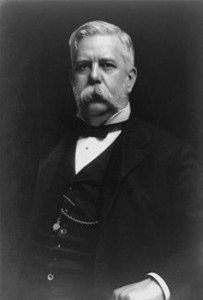George Westinghouse
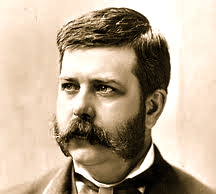
Westinghouse
George Westinghouse changed the face of the world with his inventions, patents, business sense, and personality. Not a day goes by that we don’t use something pioneered by George Westinghouse. He is the forgotten role model that our country needs today to teach future generations of Americans that hard work and kindness pay off. George Westinghouse was one of the most successful men in the world. A respected engineer, inventor and America’s greatest industrialist. He was a pioneer of the industrial revolution and played a leading role in turning the United States from a young agrarian society into a modern economic powerhouse. The name “Westinghouse” has been a household name the world over for more than 100 years because of one man, his love of machines, and his desire to make the world a better place. The accomplishments that George Westinghouse had in his lifetime had a major impact on the way we live today. His work in the railroad industry with the Westinghouse air brake, the electrification of the world with Westinghouse alternating current, him being instrumental in developing natural gas as a fuel, and his impact on the shipping industry with the Westinghouse geared marine turbine engine. George Westinghouse was known as a good person. He always had a very good rapport with his workers. There was never a strike at any of the Westinghouse companies all the time he had control of them. And, you know, that was not common back in those days. He certainly was not motivated by greed or money. He really thought that his accomplishments would benefit mankind. And that alone was a driving force for him.
(born October 6, 1846 – died March 12, 1914) was an American entrepreneur and engineer who invented the railway air brake and was a pioneer of the electrical industry. Westinghouse was one of Thomas Edison‘s main rivals in the early implementation of the American electricity system. Westinghouse’s system ultimately prevailed over Edison’s insistence on direct current. In 1911, Westinghouse received the AIEE’s Edison Medal “For meritorious achievement in connection with the development of the alternating current system.”
Early years
He was born in Central Bridge, NY in 1846. He was the son of a machine shop owner and was talented at machinery and business. At the age of fifteen, as the Civil War broke out, he enlisted in the New York National Guard until his parents urged him to return home. Two years later in 1863, he persuaded his parents to allow him to re-enlist and joined the New York Cavalry. In December 1864 he resigned from the Army to join the Navy, serving as Acting Third Assistant Engineer on the USS Muscoota through the end of the war. In 1865 he returned to his family in Schenectady and enrolled at nearby Union College. However, he lost interest in the curriculum and dropped out in his first term there.
 Westinghouse was 19 years old when he created his first invention, the rotary steam engine. He also devised the Westinghouse Farm Engine. At age 21 he invented a “car replacer”, a device to guide derailed railroad cars back onto the tracks, and a reversible frog, a device used with a railroad switch to guide trains onto one of two tracks.
Westinghouse was 19 years old when he created his first invention, the rotary steam engine. He also devised the Westinghouse Farm Engine. At age 21 he invented a “car replacer”, a device to guide derailed railroad cars back onto the tracks, and a reversible frog, a device used with a railroad switch to guide trains onto one of two tracks.
In 1867, Westinghouse met and soon married Marguerite Erskine Walker. In their nearly forty-seven years of marriage they had one son, George Westinghouse 3rd. The couple made their first home in Pittsburgh, Pennsylvania. They later acquired houses in Lenox, Massachusetts and in Washington, District of Columbia. Mrs. Westinghouse died only a few months after her husband.
At about this time, he witnessed a train wreck where two engineers saw one another, but were unable to stop their trains in time using the existing brakes. Brakemen ran from car to car, on catwalks atop the cars, applying the brakes manually on each car.
 Westinghouse Steam and Air Brakes (U.S. Patent 144,006)
Westinghouse Steam and Air Brakes (U.S. Patent 144,006)
In 1869, at age 22, he invented a railroad braking system using compressed air. The Westinghouse system used a compressor on the locomotive, a reservoir and a special valve on each car, and a single pipe running the length of the train (with flexible connections) which both refilled the reservoirs and controlled the brakes, applying and releasing the brakes on all cars simultaneously. It is a failsafe system, in that any rupture or disconnection in the train pipe will apply the brakes throughout the train. It was patented by Westinghouse on October 28, 1873. The Westinghouse Air Brake Company (WABCO) was subsequently organized to manufacture and sell Westinghouse’s invention. It was in time nearly universally adopted. Modern trains use brakes in various forms based on this design. The same conceptual design of fail-safe air brake is also found on heavy trucks.
Westinghouse pursued many improvements in railway signals (then using oil lamps), and in 1881 he founded the Union Switch and Signal Company to manufacture his signaling and switching inventions.
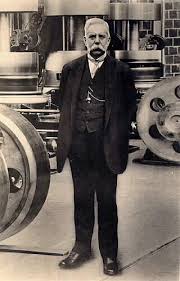 Electricity and the “War of Currents“
Electricity and the “War of Currents“
In 1879 Edison invented an improved incandescent light bulb, and realized the need for an electrical distribution system to provide power for lighting. On September 4, 1882, Edison switched on the world’s first electrical power distribution system, providing 110 volts direct current (DC) to 59 customers in lower Manhattan, around his Pearl Street Station.
Westinghouse’s interests in gas distribution and telephone switching logically led him to become interested in electrical power distribution. He investigated Edison’s scheme, but decided that it was too inefficient to be scaled up to a large size. Edison’s power network was based on low-voltage DC, which meant large currents and serious power losses. An AC power system allowed voltages to be “stepped up” by a transformer for distribution, reducing power losses, and then “stepped down” by a transformer for consumer use.
A power transformer developed by Lucien Gaulard of France and John Dixon Gibbs of England was demonstrated in London in 1881, and attracted the interest of Westinghouse. Transformers were not new, but the Gaulard-Gibbs design was one of the first that could handle large amounts of power and was easily manufactured. In 1885 Westinghouse imported a number of Gaulard-Gibbs transformers and a Siemens AC generator to begin experimenting with AC networks in Pittsburgh.
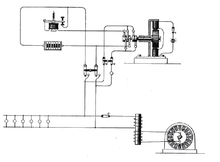 Westinghouse Early AC System 1887 (U.S. Patent 373,035)
Westinghouse Early AC System 1887 (U.S. Patent 373,035)
Assisted by William Stanley, and Franklin Leonard Pope, Westinghouse worked to refine the transformer design and build a practical AC power network. In 1886 Westinghouse and Stanley installed the first multiple-voltage AC power system in Great Barrington, Massachusetts. The network was driven by a hydropower generator that produced 500 volts AC. The voltage was stepped up to 3,000 volts for transmission, and then stepped back down to 100 volts to power electric lights. That same year, Westinghouse formed the “Westinghouse Electric & Manufacturing Company,” which was renamed the “Westinghouse Electric Corporation” in 1889.
Thirty more AC lighting systems were installed within a year, but the scheme was limited by the lack of an effective metering system and an AC electric motor. In April 1888, Westinghouse and his engineer Oliver B. Shallenberger developed an induction meter that used a rotating magnetic field for measuring alternating current (ampere-hours). The same basic meter technology remains in use today. That same year the inventor Nikola Tesla demonstrated a polyphase brushless AC induction motor also based on a rotating magnetic field. In July 1888, George Westinghouse licensed Nikola Tesla‘s US patents for the induction motor and transformer designs. Westinghouse also purchased a US patent option on a possible prior design for an induction motor from the Italian physicist and electrical engineer Galileo Ferraris in an attempt to avoid the rather substantial amount of money being asked to secure the Tesla license, but concluded it was too risky not to obtain what may have been a priority Tesla US patent.
Westinghouse’s promotion of AC power distribution led him into a bitter confrontation with Edison and his DC power system. The feud became known as the “War of Currents.” Edison claimed that high voltage systems were inherently dangerous. Westinghouse replied that the risks could be managed and were outweighed by the benefits. Edison tried to have legislation enacted in several states to limit power transmission voltages to 800 volts, but failed.
The battle went to an absurd level when, in 1887, a board appointed by the state of New York consulted Edison on the best way to execute condemned prisoners. At first, Edison wanted nothing to do with the matter.
 Probably the most famous American electric chair—Old Sparky from Sing-Sing Prison.
Probably the most famous American electric chair—Old Sparky from Sing-Sing Prison.
Westinghouse AC networks were clearly winning the battle of the currents, and the ultra-competitive Edison saw a last opportunity to defeat his rival. Edison hired an outside engineer named Harold P. Brown, who could pretend to be impartial, to perform public demonstrations in which animals were electrocuted by AC power. Edison then told the state board that AC was so deadly that it would kill instantly, making it the ideal method of execution. His prestige was so great that his recommendation was adopted.
Harold Brown then sold gear for performing electric executions to the state for $8,000. In August 1890, a convict named William Kemmler became the first person to be executed by electrocution. Westinghouse hired the best lawyer of the day to defend Kemmler and condemned electrocution as a form of “cruel and unusual punishment.” Of the first 17 seconds that the current flowed, meant to kill the man, he survived. People were horrified and scrambled to turn the current back on, although no one is quite sure how long the second burst lasted. A reporter got a hold of Westinghouse in Pittsburgh and asked about the execution. “I do not care to talk about it. It has been a brutal affair. They could have done better with an axe.” The electric chair became a common form of execution for decades, although it had been proven to be unsatisfactory for the task. However, Edison failed to popularize the term “Westinghoused” for what happened to those sentenced to death.
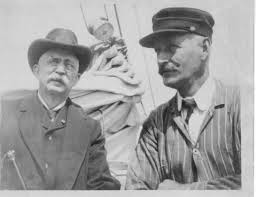 Edison also failed to discredit AC power, whose advantages outweighed its hazards. Westinghouse was able to build pivotal projects using AC power such as the Ames Hydroelectric Generating Plant in 1891 and the original Niagara Falls Adams Power Plant in 1895 which proved to be a success. Even General Electric, which absorbed Edison General Electric in 1892, decided to begin production of AC equipment.
Edison also failed to discredit AC power, whose advantages outweighed its hazards. Westinghouse was able to build pivotal projects using AC power such as the Ames Hydroelectric Generating Plant in 1891 and the original Niagara Falls Adams Power Plant in 1895 which proved to be a success. Even General Electric, which absorbed Edison General Electric in 1892, decided to begin production of AC equipment.
In 1889, Westinghouse hired Benjamin G. Lamme (1864–1924) electrical engineer and inventor. Interested in mechanics and mathematics from childhood, Lamme graduated from Ohio State University with an engineering degree (1888). Soon after joining Westinghouse Corp, he became the company’s chief designer of electrical machinery. His sister and fellow Ohio State graduate, Bertha Lamme (1869–1943), the nation’s second woman electrical engineer, joined him in his pioneering work at Westinghouse until her marriage to fellow Westinghouse engineer, Russel Feicht. Among the electrical generating projects attributed to Bertha Lamme is the turbogenerator at Niagara Falls. The New York, New Haven and Hartford Railway adopted the Lamme’s single-phase overhead electrification system in 1905. Benjamin Garver Lamme was Westinghouse’s chief engineer from 1903 until his death.
Later years
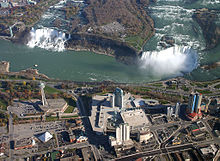 Aerial view of Niagara Falls, with American Falls on the left and the Horseshoe Falls on the right
Aerial view of Niagara Falls, with American Falls on the left and the Horseshoe Falls on the right
In 1893, in a significant victory, the Westinghouse company was awarded the contract to set up an AC network to power the World’s Columbian Exposition in Chicago, giving the company and the technology widespread positive publicity. Westinghouse also received a contract to set up the first long-range power network, with AC generators at Niagara Falls producing electricity for distribution in Buffalo, New York, 40 kilometers (25 mi) away.
With AC networks expanding, Westinghouse turned his attention to electrical power production. At the outset, the available generating sources were hydroturbines where falling water was available, and reciprocating steam engines where it was not. Westinghouse felt that reciprocating steam engines were clumsy and inefficient, and wanted to develop some class of “rotating” engine that would be more elegant and efficient.
One of his first inventions had been a rotary steam engine, but it had proven impractical. British engineer Charles Algernon Parsons began experimenting with steam turbines in 1884, beginning with a 10 horsepower (7.5 kW) . Westinghouse bought rights to the Parsons turbine in 1885, and improved the Parsons technology and increased its scale.
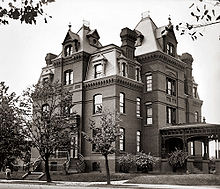 Washington, D.C. residence of George Westinghouse from 1901 to 1914
Washington, D.C. residence of George Westinghouse from 1901 to 1914
In 1898 Westinghouse demonstrated a 300 kilowatt unit, replacing reciprocating engines in his air-brake factory. The next year he installed a 1.5 megawatt, 1,200 rpm unit for the Hartford Electric Light Company.
Westinghouse then developed steam turbines for maritime propulsion. Large turbines were most efficient at about 3,000 rpm, while an efficient propeller operated at about 100 rpm. That required reduction gearing, but building reduction gearing that could operate at high rpm and at high power was difficult, since a slight misalignment would shake the power train to pieces. Westinghouse and his engineers devised an automatic alignment system that made turbine power practical for large vessels.
Westinghouse remained productive and inventive almost all his life. Like Edison, he had a practical and experimental streak. At one time, Westinghouse began to work on heat pumps that could provide heating and cooling, and believed that he might be able to extract enough power in the process for the system to run itself.
Any modern engineer would clearly see that Westinghouse was after a perpetual motion machine, and the British physicist Lord Kelvin, one of Westinghouse’s correspondents, told him that he would be violating the laws of thermodynamics. Westinghouse replied that might be the case, but it made no difference. If he couldn’t build a perpetual-motion machine, he would still have a heat pump system that he could patent and sell.
With the introduction of the automobile after the turn of the century, Westinghouse went back to earlier inventions and devised a compressed air shock absorber for automobile suspensions.
 The Westinghouse Memorial in Schenley Park.
The Westinghouse Memorial in Schenley Park.
Westinghouse remained a captain of American industry until 1907, when a financial panic led to his resignation from control of the Westinghouse company. By 1911, he was no longer active in business, and his health was in decline.
George Westinghouse died on March 12, 1914, in New York City, at age 67. As a Civil War veteran, he was buried in Arlington National Cemetery, along with his wife Marguerite, who survived him by three months. Although a shrewd and determined businessman, Westinghouse was a conscientious employer and wanted to make fair deals with his business associates.
In 1918 his former home was razed and the land given to the City of Pittsburgh to establish Westinghouse Park. In 1930, a memorial to Westinghouse, funded by his employees, was placed in Schenley Park in Pittsburgh. Also named in his honor, George Westinghouse Bridge is near the site of his Turtle Creek plant. Its plaque reads:
 “In Boldness Of Conception, In Greatness and In Usefulness To Mankind This Bridege Typifies The Character And Career of George Westinghouse (born 1846-died 1914) In Whose Honor It WAs Dedicated On September 10, 1932.”
“In Boldness Of Conception, In Greatness and In Usefulness To Mankind This Bridege Typifies The Character And Career of George Westinghouse (born 1846-died 1914) In Whose Honor It WAs Dedicated On September 10, 1932.”
The George Westinghouse, Jr., Birthplace and Boyhood Home was listed on the National Register of Historic Places in 1986.

